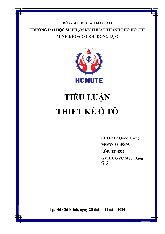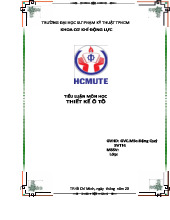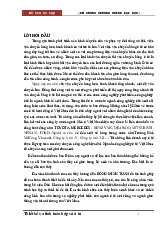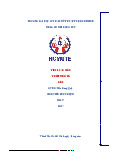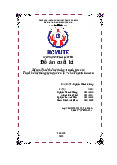





Preview text:
HO CHI MINH CITY UNIVERSITY OF
Major:Automotive Engineering Technology TECHNOLOGY AND EDUCATION Level:Undergraduate
Faculty of Vehicle and Energy Engineering
Program: Automotive Engineering
VEHICLE DESIGN COURSE SYLLABUS
1. Vietnamese name: Thiết kế ô tô
2. English name: Vehicle Design
Course code: VEDE 320231E
3. Credit number: 2 credits (2/0/4) (2 credits on class, 0 credit on laboratory, 4 credits at home)
Contribute to 15 weeks (2 hours on class/week + 0 hours on laboratory + 4 hours selfstudy per week) 4. Instructors: 1/ MSc. Dang Quy 2/ PhD. Lam mai Long 3/ ME. Tran dinh Quy
5. Conditions for registration:
Students have studied: Engineering Mechanics, Strength of Materials, Machine parts and
principles and Vehicle Dynamics. 6. Course Description
This course equips the students with fundamental knowledge about principles,
composition, characteristics about kinematics and dynamics of clusters and systems of
automotive powertrains and chassis.
Providing students with the methods of fundamental calculation for testing workable
ability of components, clusters and systems of automotive powertrains and chassis.
And it is the basis for designing a new car or advancing and renovating a old car.
7. Course Goals Goals Goals Objectives Expected
(The course aims to provide students with:) Learning Outcome of Program G1
Speciazed knowledge in area of Automotive Engineering ELO 2, ELO 3 technology such as: -
Knowledge about principles of kynematics and
dynamics of systems of automotive powertrains and chassis -
Calculating and designing ability for kinematics and
dynamics of systems of automotive powertrains and chassis. G2
Analytic, explaining abilities for solving of automotive ELO 5, ELO 6, engineering problems. ELO 7 G3
Teamwok skill, communication and abtility to read and ELO 8, ELO 9,
understand technical documents in English ELO 10 G4
Students are able to calculate and experiment the ELO 12, ELO 13,
durability of components of systems of automotive ELO 16 powertrains and chassis.
8. Course objectives and ELO Course Description Expected objectives
(After completing program, students are able :) Learning Outcome of Program
To presenthow to detemine the basic size of clutch, method of G1.1
calculation and characteristic of hydraulic clutch. ELO 2 G1
To calculate geometric parameters of gears of transmission. To G1.2
present calculating, characteristics of the torque converter and ELO 3
determining gear ratio of planetary transmissions.
To understand kinematics of cardan mechanism and to calculate G2.1
dangerous revolution of cardan driveshaft. ELO 5
To present and to calculate the parts of drive axle: reducing G2 G2.2
transmissons, differential and axle halfshaft. ELO 6
To find his-self documents, to self-study and to present contents in G2.3
branch of automotive technology. ELO 7
To have the ability to work in group to discuss and resolve G3.1
problems related to the automobile calculations. ELO 8 G3
To understand english terms for the issue of calculating and G3.2 designing vehicles. ELO 9
To set ideas and goals renovated old car pieces for new cars with G4.1 the advantages enjoyable. ELO 10 G4.2
To calculate parts of suspension system, to understand sringy ELO 12
characteristics and characteristics of shock absorbers. G4 G4.3
To understand steering ratios of steering system, to calculate and design steering system. ELO 13 G4.4
To calculate needed braking torque in brake mechanism and braking actuating ELO 16 9.References - Textbooks:
1. MSc.Dang Quy, Vehicle Design, University of Technology and Education HCMC 2017
2. Prof. DrSc.Nguyen Huu Can,Vehicle Design and Calculation,Education Pulisher, 1996. - Reference textbooks:
1.Fenton, J. , “Handbook of Vehicle Design Analysis”, Professional Engineering Publishing, Ltd., Suffolk (UK) – 1996. 2.Fenton, J. , “ Professional
Handbook of Automotive Powertrains and Chassis Design”,
Engineering Publishing, Ltd., Suffolk (UK) – 1998.
10. Assesements: (Assesement can be chosen by lecturer) - Grade Scale: 10 - Plan for assesements Methods Methods ELO Rate for of Content Time assesement grade s (%) I. Midterm exam 50 1) Attendance 10
Absent 0 session : get 10 points Check Check
Absent 1 session : get 8 points every attendance
Absent 2 sessions : get 6 points sessions
Absent 3 sessions : get 4 points
Absent 4 sessions : get 2 points
Absent 5 sessions : fail this course 2) First midterm exam 20 ELO2 Open book
Content exam covers all learning Writing Week 6 ELO3 exam outcomes from week 1 to week 5 ELO5 3) Second midterm exam 20 ELO6 ELO7 ELO8 ELO9
Content exam covers all learning Closed Week
outcomes from week 6 to week 10 Writing ELO1 book exam 11 0 ELO1 1 ELO1 2 II. Final exam 50 ELO2 ELO3 ELO5 ELO6 ELO7 ELO8 ELO9 ELO1
Students do calculated assignments 0 Week
related to studied theory. Students Grading ELO1 Assigment 12 to
submit reports for appraising and reports 1 week 15 grading. ELO1 2 ELO1 3 ELO1 4 ELO1 5 ELO1 6 Week Content ELOs
Chapter 1: Overview of vehicle design
A/ Contents and teaching methods in class: (1)
Theory teaching contents: ElO7
1.1 General overview of vehicle design ElO8
1.2 The order in vehicle design calculations
1.3 Overview of design calculations powertrain ElO10
1.4 Overview of design calculations braking system
1.5 Overview of design calculations suspension system 1
1.6 Overview of design calculations steering system Teaching method: + Presentation + Discussion + Team working 11. Contents:
B/ Contents for self-study at home:(2)
- Reading the related reference textbooks ElO8
- Searching related materials at Internet
Chương 2: Overview about vehicles
A/ Contents and teaching methods in class: (1)
Theory teaching contents:
2.4 Vehicle overall disposition 1 ElO7 Teaching method: ElO8 + Presentation ElO10 + Discussion + Team working
B/Contents for self-study at home: (2) 2.1 Vehicle classification ElO8
2.2 The requirements for vehicle 2.3 The parameters of vehicle
Chapter 3: The loads exerted on the clusters and details of vehicles
A/Contents and teaching methods in class: (1)
Theory teaching contents:
3.1 The concept of the types of loads
3.3 Loads used in calculating on the clusters and details of ElO8 vehicles ElO10 Teaching method: + Presentation + Discussion + Team working
B/Contents for self-study at home:(2) ElO10
3.2 Events induce dynamic loads
Chapter 4: Clutch
A/ Contents and teaching methods in class: (1) 2
Theory teaching contents:
4.3 Calculating basic dismensions of clutch Teaching method: ElO2 + Presentation + Discussion + Team working
B/Contents for self-study at home: (2)
4.1 Utility, classification and requirement of clutch ElO2
- Homework: calculating basic dimensions of clutch
Chapter 4: Clutch (cont.)
A/ Contents and teaching methods in class: (2)
Theory teaching contents:
4.4 Sliding work appears when engaging clutch 3 4.5 Hydraulic clutch ElO2 12. Ethics:
Students have to do themselves all projects and tasks. University have a appropriate
punishment for students who break law or have illegal action such as copy or
paradigm and certainly these students’s score is equal to zero. 13. Approved date: 14. Approved by: Dean of faculty Head of department Instructor
